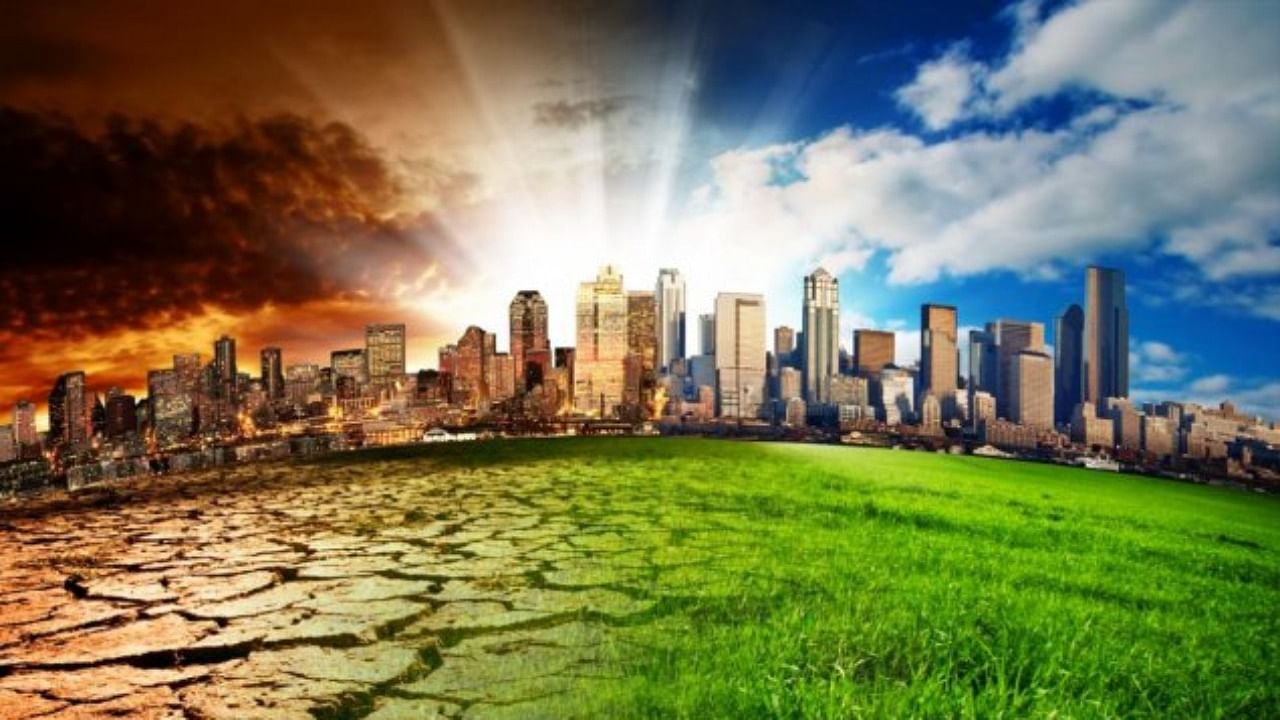
Among the global environmental issues, climate change is the biggest challenge for the humanity triggered by the mounting Green House Gases (GHGs) and consequent increase in earth’s average temperature by 0.18°C in the last one decade. The UN is striving to restore earth’s ecosystems by 2030 with the active support and commitment of investors, business, government and communities.
However, this largely depends on the commitment of countries in achieving climate targets as per the international agreement under the United Nations Framework Convention on Climate Change (UNFCCC). The failure to achieve the targets of Kyoto Protocol and lack of consensus among the countries in the Paris agreement shows collective failure of the international community.
The World Economic Forum’s Report on Global Risk, 2020, observes that “climate action failure” is a threat to economic stability of the world countries which witnessed unprecedented extreme weather and intense and more frequent natural disasters.
Even though economic development has made the world economy richer with $83 trillion, it has made the world environmentally poor due to emission of GHGs and consequent global warming which imposes $100 billion economic and environmental cost on the society at large.
The impact of climate change is ubiquitous and more frequent worldwide concerning extreme events of temperature, intense droughts and floods, insect outbreaks and health impacts like Covid-19, depletion of biodiversity and ecosystem services, declining water resources, recurring wildfire, dwindling agricultural yields, coastal submergence etc. The root causes for global warming and emission of GHGs are, undeniably, rapid industrialisation, urbanisation, transportation and mass consumerism under the economic model of capitalism which has squarely undermined the ecosystem services of the earth. Climate change is global and obviously affects everyone. However, economic development benefits a few due to inequal distribution of income or benefits.
In contrast, industries and corporate companies which largely contribute to climate change, hardly spend on the efforts of mitigating climate change. The planetary emergency is apparent as ‘privatising the profits and universalising pollution’ has been continued. In other words, the cost towards mitigation and adaptation of climate change is largely borne by the government and people and profits are appropriated by the business.
The main sources of global climate finance available under the UNFCCC are: Global Environment Facility replenishment; Special climate change fund; Least developed countries fund; Bilateral and multilateral sources etc. As per the Climate Policy Initiatives on the Global of Climate Finance, 2019, which tracked the total global finance of $579 billion, 44% and 56% respectively, constitute public and private finances.
The main concern is that about 93% of the total public and private finances flow to mitigation activities while adaptation activities receive less than 7%. Further, the private finance coverage of various sectors is limited to transport and renewable energy, whereas public finance covers energy efficiency, adaptation, land use and others apart from transport and renewable energy.
The geographical distribution of global finance shows that developed countries source their finance from private sources whereas developing countries rely on public funding. This clearly indicates the grave situation of global governance failure of climate financing in the world and India in particular.
India’s economy is facing unprecedented effects of climate change and frequent occurrences of natural disasters which cost nearly 3% of the GDP. India’s 40% poor continue to suffer the impact of climate change with their limited economic resilience. The poverty reduction programmes continue to fail due to the frequent onslaught of natural disasters like Amphan and Yass cyclones and Covid-19 which has pushed millions of people under poverty line and further rise the income inequality.
The estimated cost of damage in West Bengal caused by recent cyclone Amphan was $13.2 billion. India’s agriculture sector is highly vulnerable to frequent floods and deficient monsoons which drastically altered the crop cycles and reduced productivity causing loss of income to millions of farmers, agricultural labourers and fishermen.
Water shortage
The shortage of drinking water, and heat waves are highly prevalent in several parts of the country making the poor highly vulnerable. The loss of biodiversity, forests and habitats affect the forest dependent communities. A World Health Organisation study (1995) shows that seasonality, distribution, and prevalence of vector-borne diseases are influenced significantly by climate change.
There is a strong association between frequent changes in weather and rise in infections such as cold, fever, headache, vomiting, tiredness, breathlessness, asthma etc. The spread of new infectious diseases involves humans and animals; scientists have observed that about 60% of all infectious diseases are zoonotic in nature and animals infect humans due to habitat fragmentation influenced by land use and climate change.
India is committed to the Paris Agreement; post-2020 climate goals state that the country will reduce 33-35% in the emission intensity of its economy by 2030 compared to the 2005 levels and increase forest cover aimed at reducing CO2 levels equivalent to $2.5 billion to 3 billion by 2030.
However, deficient climate finances may limit realising the climate targets. As per the estimates, India’s Nationally Determined Contribution to achieve the climate targets demand Rs 11 lakh crore or $170 billion annually whereas, the actual dedicated climate finance was 12% or Rs 1,37,000 crore ($21 billion) during 2018. The institutional financing policy towards mitigation and adaptation of climate change remains a challenge, given the poor financial resources made available in India.
Most of the funds are targeted to achieve energy efficiency, investment on renewable energy and sustainable transport but afforestation and adaptation receive a raw deal. The UN commits to “putting ecosystem restoration on a pedestal” but its realisation largely lies on active support of investors in financing of climate change in developing countries especially in cash-strapped South Asia and African countries.
(The writer is Professor, Institute of Socio-Economic Change, Bengaluru)